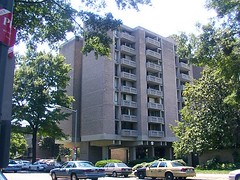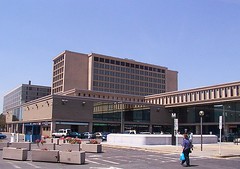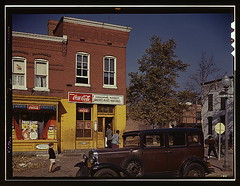More about Contested Space--"Gentrification"
I don't like to use the word "gentrification," because it's usually used in a pejorative way, and because it gets in the way of specificity, in figuring out what someone is talking about, and makes it difficult to accurately respond from a policy perspective.
Anyway, I wiped the cobwebs off something I wrote last year, and added a couple things...
For what it's worth, this is something I wrote about displacement effects in a new urbanism forum. Gentrification effect (2) is what I think people really mean when they are talking about "gentrification," new and different people coming into a neighborhood. Of course, in neighborhoods like CH, displacement is really happening.
As far as displacement goes, it's part of what people call "gentrification". But gentrification is phenomenon with multiple effects, which I describe as:
(1) new investment in a previously underinvested area;
(2) change and different people coming into a neighborhood -- most importantly, different people from those currently in residence (the differences--race, class, ethnicity, levels of educational attainment, attitudes toward the urban experience, etc.--are usually not "celebrated" (I make this point because I still remember first being taught about diversity and multiculturalism in 7th grade, and I specifically remember the "melting pot" and "celebration of differences" phrase -- I have a hard time seeing the celebration, at least in DC);
(3) increase in conversion of previously rented dwellings to owner-occupied, leading to a displacement of renters and an overall reduction of the number of rental units available in the neighborhood;
(4) related to the new demand for living in the neighborhood is an increase in rental rates, which contributes to the displacement of low- and moderate-income residents;
(5) neighborhood improvement as investment (primarily through the renovation and sale of houses to new residents) continues to increase and begins approaching critical mass (cf. Goetze Building Neighborhood Confidence;
(6) faux-displacement as long-time residents decide to "cash out" and take profits on the sale of the finally appreciated property (this is accelerated by, in my opinion, the still prevalent pro-suburban, anti-city attitudes embraced by particular demographics that tend to represent the long time population groups in traditional center cities); and
(7) ongoing increases in property tax assessments which contributes to the displacement of longtime residents on fixed or lower incomes (note that this effect is hard to separate out from [6]).
Note that Lance Freeman's work which finds that displacement doesn't increase with "neighborhood improvement" is explained by the fact that lower-income households want to stay in nicer neighborhoods, just like anybody else, and respond by doubling up (increasing the number of rent-payers in a household) and/or by paying more of their total household income stream in rent.
IMO the biggest effects that people seem to be referring to when they talk about "gentrification" are (2) new and different people, and (3)/(4) the displacement of renters-long-term residents. They often confuse "cashing out" (6) with displacement, which it is not.
But a lot of the change in neighborhoods that have been underinvested in over the last 40-50 years occurs with properties that have been vacant and abandoned for many years. (This is less true in Columbia Heights DC. Displacement and conversion of lower-income housing has been a deliberate strategy in that neighborhood.)
As demand increases more of these properties come back on line. This is why I don't see much displacement in my neighborhood (although it is happening) and why I am surprised to see Census figures that assert that DC's population continues to shrink even as vacant properties are occupied again and thousands of units of new construction come on line particularly in the NW quadrant.
Part of this is due to the displacement of larger and poorer families as a result of HOPEVI programs which do not provide for one-for-one replacement of housing in total, or in terms of housing provided for lower income households. By definition this is going to reduce housing availability significantly, due to the addition of middle- and upper-income households to the mix.
Another thing to look at would be the types of people that purchase and when. For example someone like me bought because I wanted to live in the city, and I preferred a close-in location and at the time, the neighborhood was cheap. I think you can track urban homesteading by using the "diffusion of innovations" typology of Everett Rogers, which states:"Innovativeness is the degree to which an individual or other unit of adoption is relatively earlier in adopting new ideas than other members of a social system. We specify five adopter categories, classifications of the members of a social system on the basis of their innovativeness: (1) innovators, (2) early adopters, (3) early majority, (4) late majority, and (5) laggards... Rate of adoption is the relative speed with which an innovation is adopted by members of a social system."
This process varies by neighborhood and the factors that influence its appeal -- location, access to public transportation, historic building stock, employment availability, perceptions and realities concerning public safety, etc.
When I talk about property tax assessment freezes, it really has to do with gentrification effect (7). Some sort of property tax reform is in order, since an annual tax based on unrealized value that has no link to income seems unfair and undemocratic.
There isn't much of a solution for (3), other than the expansion of housing opportunities through alley dwellings (not currently favored in DC Zoning Regulations), apartments, vertical mixed use redevelopment projects, etc. It happens that DC tends not to have rowhouses as large as in Philadelphia or Manhattan, so our housing-rental capacity in the center city isn't nearly as great compared to those cities. DC's situation is further complicated because it is driven in part by an atypical market force, a marginal increase in the desire to live in the center city, which is driven by "trend," an appreciation for historic building stock, access to public transportation and employment centers, etc. Because of the limited availability of historic building stock, we have a hyper situation.
I don't agree with people who state that urban renewal was designed to stabilize neighborhoods as opposed to spurring overall neighborhood and city "improvement". Clearance was all about starting fresh, particularly in SW DC which was one of the earliest "test cases" (as was New Haven but I am not familiar with happened there).
The book Community Economic Development Handbook by Temali makes the point that neighborhood revitalization shouldn't mean improving a neighborhood by removing one class of (poorer) people and replacing them with another class of higher income people. That in a nutshell is the difference between revitalization and redevelopment. One is asset-based and oriented to "lifting all boats" the other is all about removal, clearance, reconstruction, and violent change. Urban renewal was not asset-based and therefore couldn't be about neighborhood stabilization.
The redevelopment in SW DC was a two-pronged approach: (1) Negro Removal; and (2) Le Corbusier tower in the park modernism for whitey.
 Tower in the Park in Southwest DC, photo from BeyondDC.
Tower in the Park in Southwest DC, photo from BeyondDC. Waterfront Mall, Southwest DC, photo from BeyondDC.
Waterfront Mall, Southwest DC, photo from BeyondDC.It was justified because of the "dilapitated" state of much of the housing in that quadrant. That is arguable as from photographs, SW didn't look much different from housing that would sell for $300,000 to $1 million per building today. However, one thing that many people don't know isthat the Federal Government held purchase options on much of SW since the 1930s, and as a result property owners stopped investing in maintenance and upgrading because after all, who ever successfully messed with Uncle Sam (at least then, before successful anti-freeway uprisings).
 Photo by Louise Rosskam, Farm Security Agency, circa 1930s. (Library of Congress). The neighborhood, like most cities in the depression, needed a buff and shine, but not destruction.
Photo by Louise Rosskam, Farm Security Agency, circa 1930s. (Library of Congress). The neighborhood, like most cities in the depression, needed a buff and shine, but not destruction.As community organizers, especially the historic preservation contingent, we deal with the repercussions of this today, because many people somehow associate historic preservation with "Negro Removal" -- when instead that came about via urban renewal and/or the construction of Interstate highways through cities.
My neighborhood specifically was a destination point for many people displaced from SW. (cf. Georgetown and the move out of the African-American population from that neighborhood, but I haven't researched that phenomenon enough to feel comfortable about commenting on it.
Labels: gentrification, neighborhood change, urban revitalization, urban sociology



0 Comments:
Post a Comment
<< Home